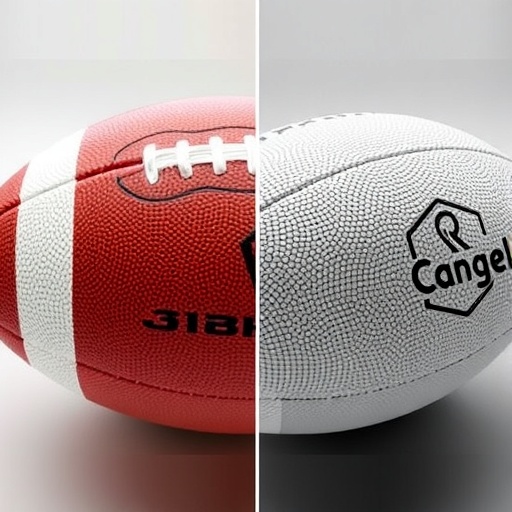In a groundbreaking study set to redefine the understanding of sports equipment, a team of researchers including Phillips, Harland, and Mitchell delves into the characteristics and mechanisms of static water uptake in both leather and synthetic association footballs. This research, published in the journal Sports Engineering, sheds light on an often-overlooked aspect of football performance that could have substantial implications for players and manufacturers alike.
Football performance is intricately tied to the materials used in the ball’s construction. This study serves to investigate how these materials respond to moisture, which can significantly affect grip, weight, and overall handling during play. The profound impact that weather conditions and pitch environments can have on a ball’s dynamics makes this research especially relevant as athletes face varying climatic conditions worldwide.
The researchers employed rigorous testing methodologies to evaluate the static water uptake characteristics of leather versus synthetic footballs. Their approach included exposing samples of both types of balls to controlled amounts of water to effectively measure how much liquid was absorbed over time. By systematically documenting the rate of absorption, the team aimed to construct a detailed profile of how each material behaves in the presence of moisture.
As the data began to accumulate, it became clear that the disparities between leather and synthetic materials were more pronounced than anticipated. Leather footballs, traditionally favored for their superior feel and control, displayed a tendency to absorb significantly more water than their synthetic counterparts. This finding raises critical questions about the implications for players who rely heavily on ball performance in wet conditions.
The study also explored the mechanisms driving water uptake in these materials. The natural fibers in leather allow for some elasticity and permeability; however, they also create a more porous structure that can retain moisture. In contrast, synthetic materials are designed to minimize absorption through tight-knit weaves that resist water infiltration, thereby maintaining performance integrity. The implications of these mechanisms are vital for understanding how different materials perform under stress.
Another key focus of the research was the potential impact of water uptake on the weight of the ball. As a football absorbs water, its weight increases, which can alter trajectory and handling during play. The researchers quantified these changes in weight, providing empirical data that players and coaches might leverage when selecting equipment for specific weather conditions.
In addition to the practical implications for players, the findings of this study have vital market relevance. With sports manufacturers continuously seeking to innovate and refine their products, understanding the water uptake characteristics of materials can guide development choices and enhance the performance standards of future footballs. This research may prompt companies to reconsider their material selections or employ new treatment processes that increase resilience against moisture.
Moreover, the study opens the door for additional research examining the long-term effects of water on football performance and durability. Future investigations could illuminate how repeated exposure to moisture affects the ball’s life cycle, ultimately informing maintenance standards for teams and their equipment managers.
As athletes train rigorously in various environments, the insights gleaned from this research can be pivotal in improving training techniques. Coaches may design drills specifically tailored to account for how footballs react to moist conditions, thereby preparing athletes to perform optimally regardless of the weather. Such an approach takes player preparation to a new level and underscores the significance of science in sports training.
Equally important is the potential for consumer education as this research unveils the hidden intricacies of football construction and material selection. Athletes of all levels can make more informed decisions when purchasing footballs, emphasizing the significance of considering environmental factors before investing in equipment.
As the results of this research gain traction within the sporting community, a ripple effect is likely to follow, inspiring further inquiry and advancement in sports engineering. The dialogue surrounding material science in sports continues to evolve, highlighting a collaborative effort between scientists, manufacturers, and athletes.
In conclusion, this study not only provides critical insights into the static water uptake characteristics of leather and synthetic footballs but also challenges long-held perceptions within the sports community. By merging scientific inquiry with practical application, the researchers bring attention to the potential for enhanced performance through better understanding and innovation.
As we continue to explore the nexus between material science and sports performance, the work of Phillips, Harland, and Mitchell stands as a testament to the importance of research-driven advancements in enhancing athlete experiences on the pitch.
Subject of Research: Water uptake characteristics of leather and synthetic footballs
Article Title: Investigating static water uptake characteristics and mechanisms for leather and synthetic association footballs
Article References:
Phillips, I., Harland, A., Mitchell, S. et al. Investigating static water uptake characteristics and mechanisms for leather and synthetic association footballs.
Sports Eng 28, 40 (2025). https://doi.org/10.1007/s12283-025-00521-8
Image Credits: AI Generated
DOI: https://doi.org/10.1007/s12283-025-00521-8
Keywords: Water uptake, football materials, sports engineering, player performance, material science.
Tags: athletic performance under varying climatic conditionscomparative analysis of football materialsfootball ball construction materialsfootball grip and handling dynamicsimpact of moisture on sports equipmentimplications for football manufacturersleather vs synthetic football performancemoisture effects on football materialssports engineering research findingsstatic water uptake characteristicstesting methodologies for sports materialswater absorption in footballs





